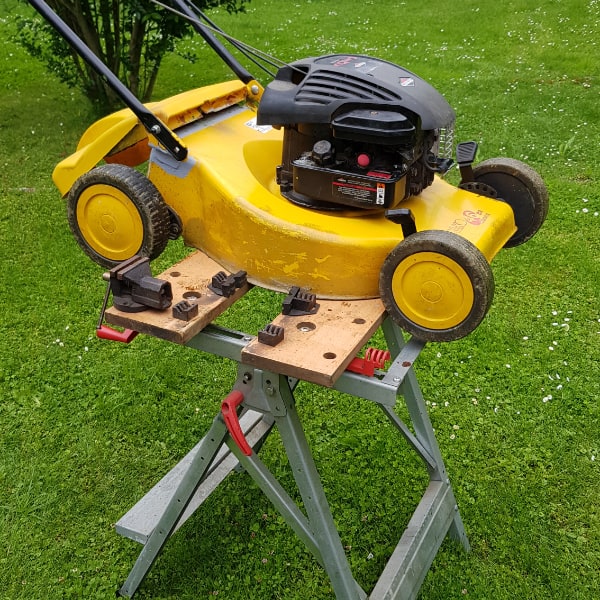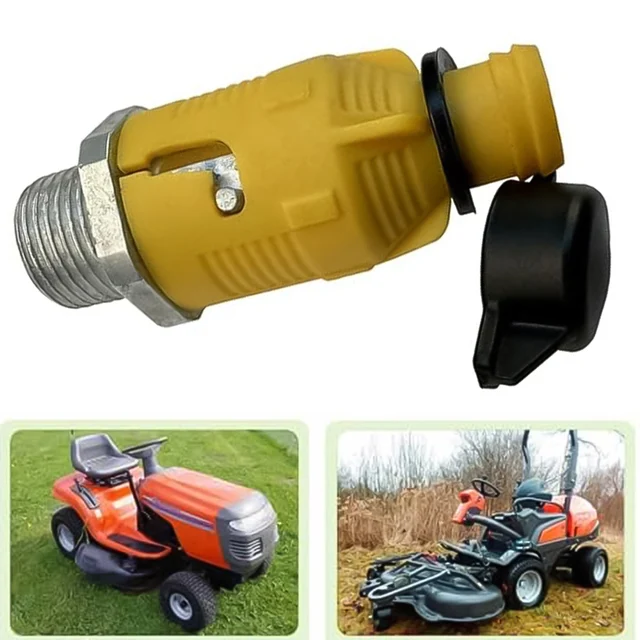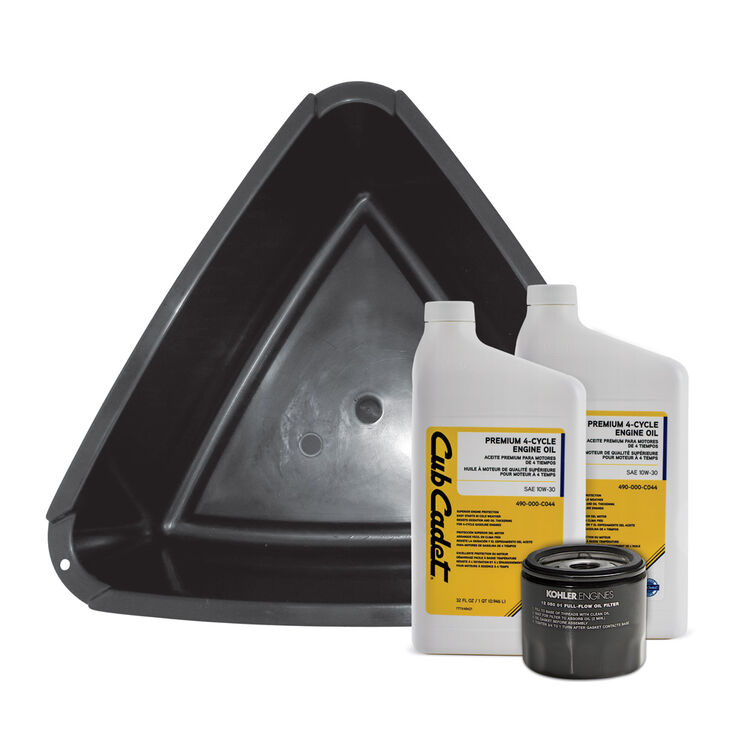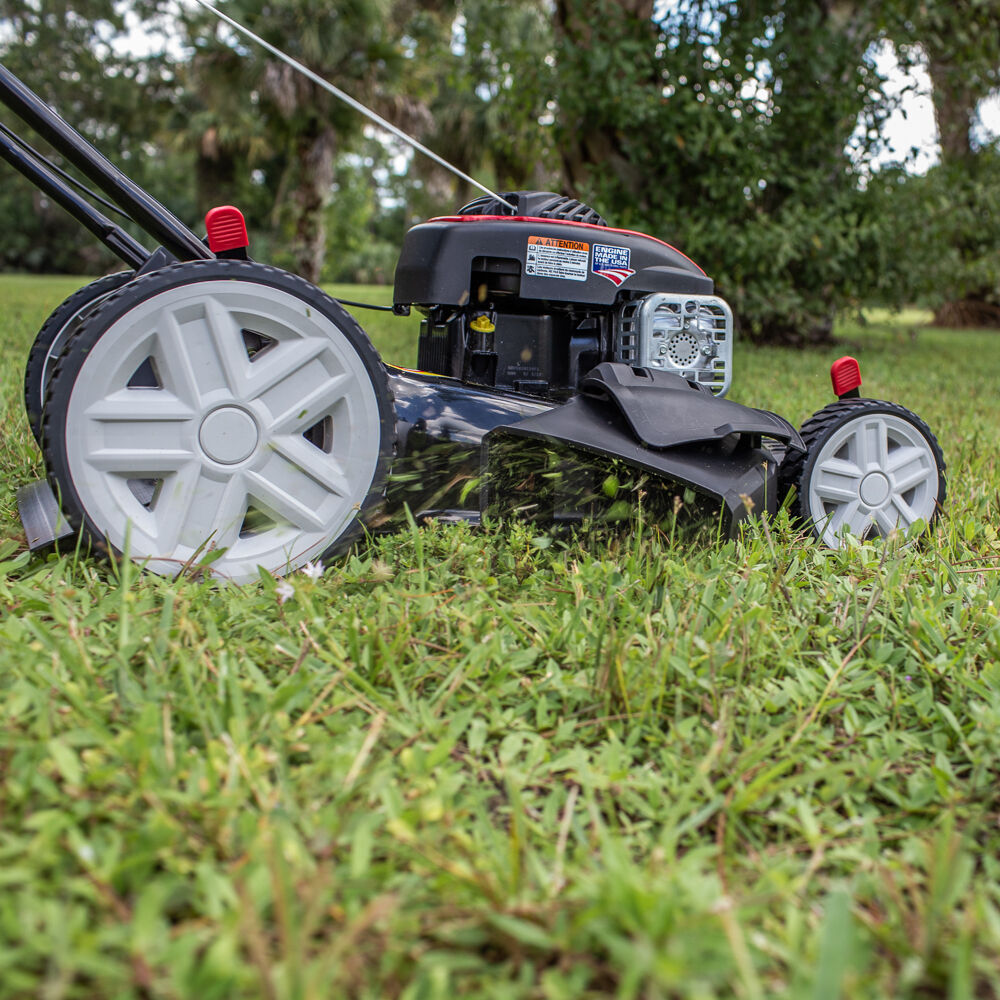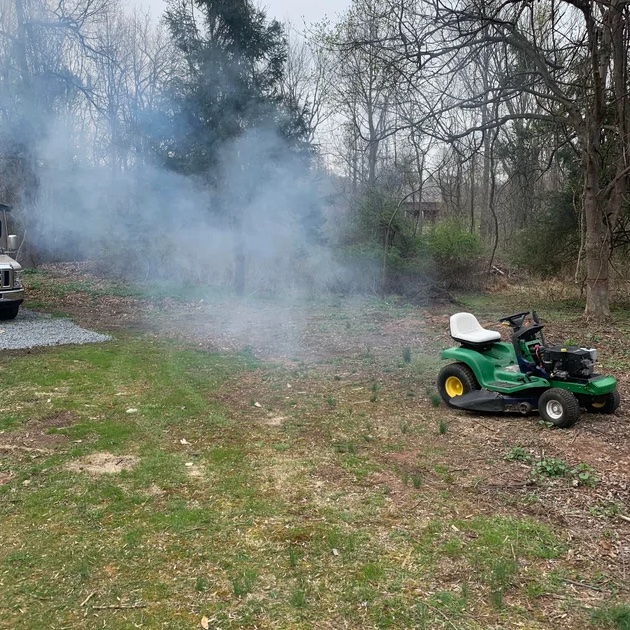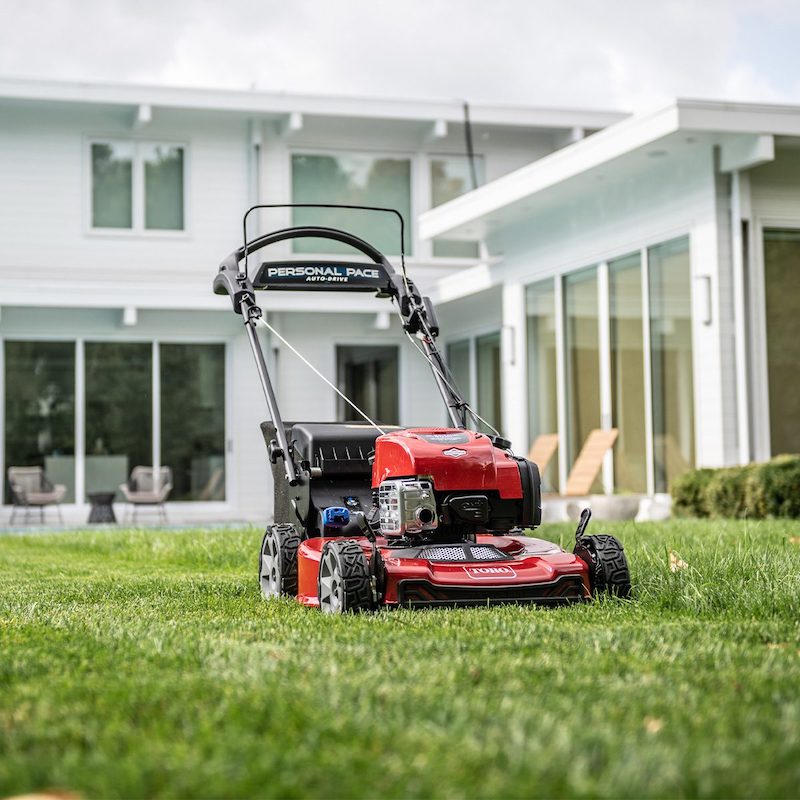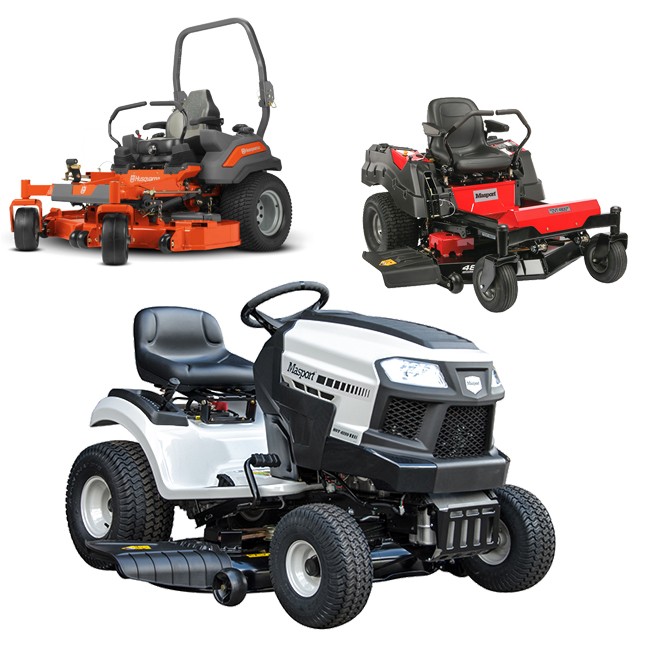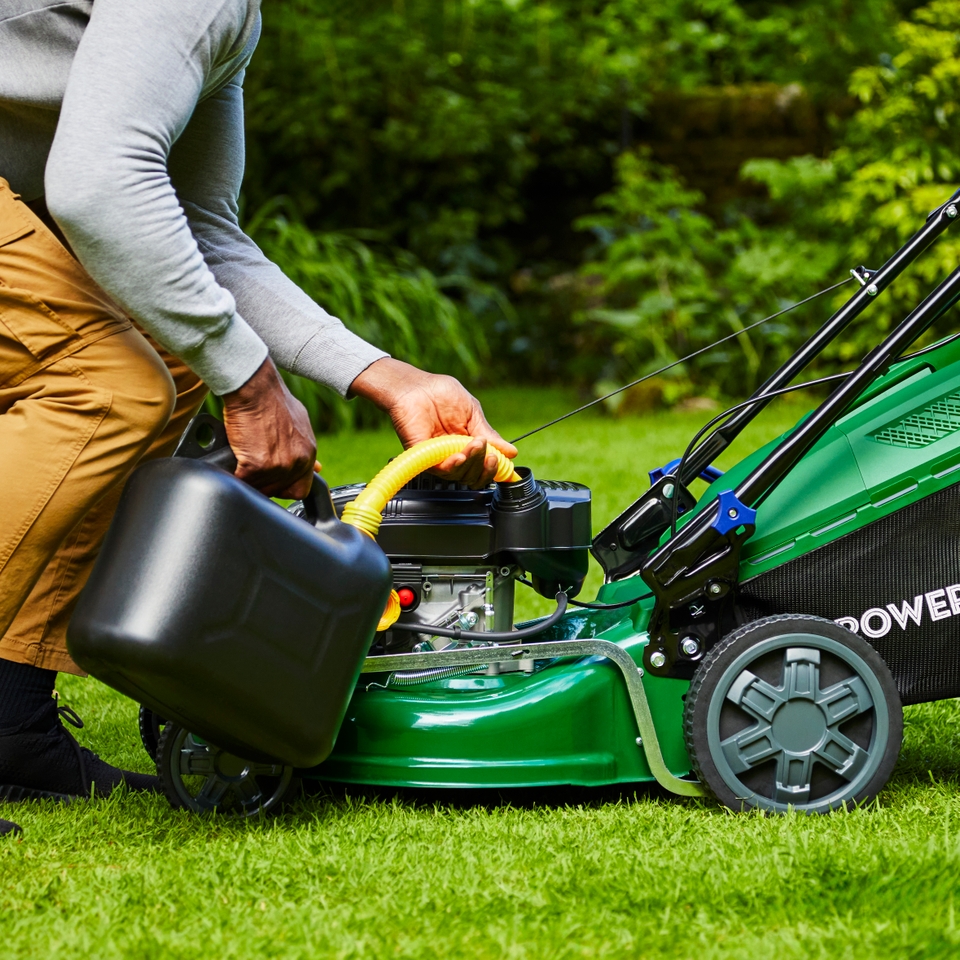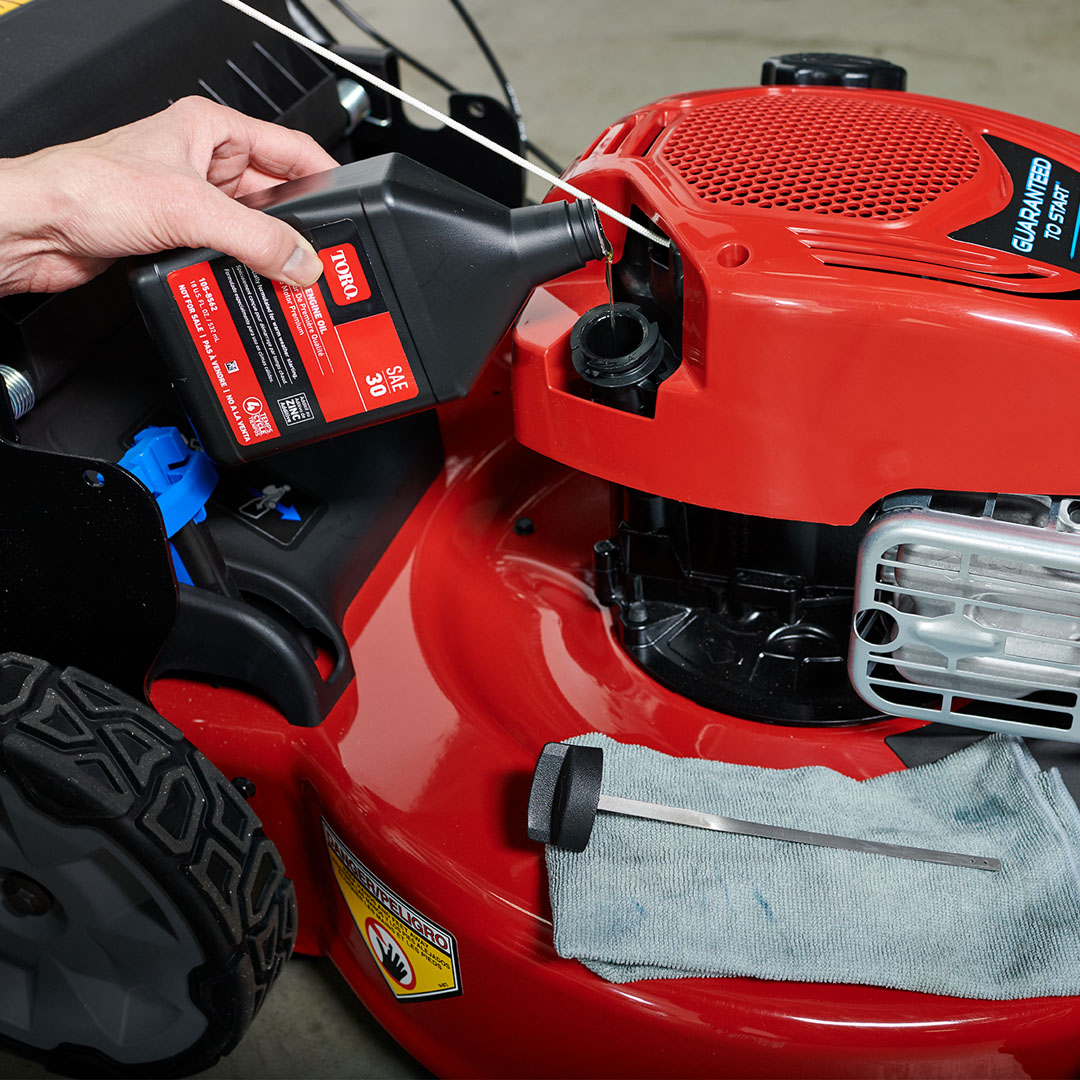
Lawn Mower Maintenance: Lawn Mower Oil Change the Right Way
Preparing for the Oil Change
Before you start the lawn mower oil change, good preparation is key. It ensures a smooth and clean process.
Warming Up the Engine
Start by warming up the engine. This helps the oil flow freely, making it easier to drain. Run the mower for a few minutes.
Cleaning the Oil Fill Area
Next, clean around the oil fill cap. Use a rag or a brush to remove any dirt, ensuring no debris gets into the engine.
Setting Up the Oil Catch Pan
Finally, place an oil catch pan next to the mower. Position it where you plan to tip the mower so it catches all the oil.
Draining the Old Oil
After preparing your lawn mower for the oil change, it’s now time to drain the old oil. This is a crucial step in ensuring your mower runs efficiently.
Removing the Oil Cap
Start by taking off the oil cap. Make sure your hands and tools are clean to prevent dirt from entering the engine.
Tipping the Mower and Draining
Gently tip the lawn mower to its side, with the oil side down. Position it so the air filter faces upward, avoiding contamination. Drain the oil into your catch pan. If there’s a drain plug underneath, use it to empty the oil more conveniently. Wait until the oil stops flowing, then set the mower back on its feet.
Replacing the Oil Filter (If Applicable)
Not all mowers have an oil filter, but if yours does, it’s vital to change it too. This keeps your mower running well.
Preparing Oil Catch for the Filter
First, put an oil catch container under the oil filter. Make sure it’s right below to catch any spills.
Unscrewing the Old Oil Filter
With the catch in place, gently unscrew the old filter. Let it drain out into your catch container.
Installing the New Oil Filter
Before screwing in the new filter, dab some oil on its seal. This helps it fit snugly. Screw it on firmly, not too tight, just until it’s securely in place.
Refilling with New Oil
Once the old oil has been fully drained from your lawn mower, it’s time to refill it with fresh, high-quality engine oil. This is an essential step to revitalize your mower’s performance and efficiency.
Gradually Adding Engine Oil
Begin by identifying the correct type of oil recommended by the manufacturer for your specific lawn mower model. Slowly pour the new oil into the engine, taking care not to overfill it. It’s better to add a little at a time, allowing the oil to settle.
The amount of oil needed can vary between models, but most require between 2/3 and 3/4 of a quart. Avoid rushing this step; adding oil gradually ensures accuracy and prevents the risk of overfilling, which can harm the engine.
Checking Oil Level with Dipstick
After adding a small amount of oil, pause to check the level with the dipstick. Wipe it clean and insert it into the oil compartment, then remove it again to see where the oil mark is. The correct level typically falls right at the ‘full’ mark, but not over it.
Repeat the process of adding oil and checking with the dipstick until the oil reaches the ideal level. Be patient and precise—accuracy here can save you from engine troubles down the line.
Once you’ve reached the desired oil level, replace the dipstick and secure the oil cap. Your lawn mower is now ready with new oil, ensuring smoother operation and longer engine life. Remember, regular lawn mower oil changes are crucial and should be performed as a part of your mower’s seasonal maintenance routine to keep it running reliably.
Final Steps
Once you have refilled your lawn mower with the new oil, there are just a couple more actions to wrap up the process.
Replacing the Oil Cap
After confirming the oil level is correct, it’s time to reseal the oil compartment. Replace the oil cap carefully and ensure it’s tight. This prevents oil from leaking and keeps contaminants out of the engine.
Disposal of Old Oil
Proper disposal of the old oil is critical for environmental protection. Transfer the used oil from the catch pan into a sealable container. Most auto parts stores accept used oil at no charge. Do not pour it down the drain or on the ground.
Follow these final steps to complete your lawn mower oil change properly. This ensures your mower operates smoothly and remains in good condition.
Seasonal Maintenance Tips
As an all-season gardener or homeowner, it’s crucial to ensure your lawn mower receives regular maintenance. This doesn’t stop at an occasional lawn mower oil change. Following a structured seasonal maintenance schedule can vastly improve your mower’s longevity and performance.
Regular Oil Change Intervals
Just like any well-oiled machine, your lawn mower requires timely oil changes. Most manufacturer manuals suggest an oil change every 20-50 operational hours. However, at a minimum, perform an oil change annually, aligning it with the onset of the mowing season.
For optimal performance of your mower, keep track of the usage hours. Set reminders for oil changes. Staying consistent helps maintain engine health and prevent malfunctions.
Additional Seasonal Tune-Up Tasks
Alongside regular lawn mower oil changes, other tune-up tasks can make a difference. These include:
- Replace or clean the air filter.
- Check spark plugs and replace if necessary.
- Inspect and sharpen the mower blades.
- Lubricate the mower’s moving parts.
- Check tire pressure and adjust as needed.
- Clean the undercarriage to prevent rust and wear.
Executing these additional tasks at the start of each season can enhance your mower’s performance. They also help avoid costly repairs. Remember that a little care goes a long way in keeping your lawn mower running smoothly.
Conclusion
Performing a lawn mower oil change is not just another task on your to-do list. It is a crucial aspect of maintaining the efficiency and longevity of your lawn mower’s engine. By neglecting this vital maintenance step, you risk facing engine problems that can lead to costly repairs or even the need for a complete replacement.
Importance of Regular Oil Changes
Regular oil changes are the heartbeat of lawn mower maintenance. Fresh oil ensures your engine runs smoothly, stays cool, and has a reduced risk of corrosion. It flushes out particles and sludge, which if left unattended, can impair your mower’s performance. Changing oil at the right intervals prevents wear and tear, ensuring that your mower is always ready when you are.
Conducting an oil change as recommended—typically between 20 to 50 hours of operation, or at least annually—can save you from greater expenses down the road. It’s a simple practice that serves as an investment in your lawn mower’s health.
Extending the Life of Your Lawn Mower
A lawn mower oil change does more than keep the engine purring; it helps extend the overall life of your lawn mower. With new oil, the engine is less prone to overheating and more capable of handling the demands of lawn care. Let’s not forget that the engine is the heart of the lawn mower; its care is paramount.
In addition to regular oil changes, other maintenance such as cleaning or replacing air filters, checking spark plugs, sharpening blades, and ensuring all parts are properly lubricated, works collectively to extend the life span of your mower. By diligently following these maintenance practices, you can help your lawn mower operate at its best for many seasons to come.
Regular maintenance is the key to reliability and longevity. It ensures that every time you pull the starter cord, you can trust your lawn mower to perform efficiently and effectively. Remember, a well-maintained lawn mower makes for a beautiful, healthy lawn and a happy homeowner.
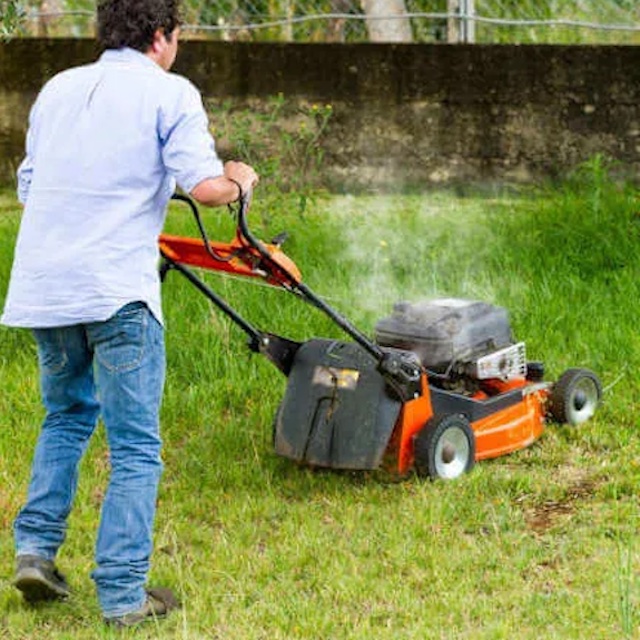
Is Your Lawn Mower Blowing White Smoke? What to Do
Introduction to Lawn Mower Smoke Issues
Is your lawn mower blowing white smoke? Experiencing smoke from your lawn mower can be alarming, but understanding the issue is key. The smoke can vary in color and each signifies different problems — some simple, others more complex. Recognizing the smoke color helps in diagnosing the problem accurately and efficiently. Knowing how to handle these situations can save you time and prevent potential damage to your mower. Armed with the right knowledge about what causes a lawn mower to emit smoke, you can identify issues quickly and decide whether it’s something you can fix yourself or if professional help is needed. Stay informed and your lawn mower will thank you through years of reliable service.
Identifying the Cause by Smoke Color
When your lawn mower emits smoke, the first step is deciphering the smoke color. Different smoke colors indicate various issues, ranging from minor problems to ones that might require professional intervention. Understanding the distinctions between white, blue, and black smoke can guide you in troubleshooting and possibly fixing the issue yourself before it escalates.
White or Blue Smoke Causes
White or blue smoke typically points to oil-related issues within your mower. If you notice this type of smoke, it could be due to an oil spill on the engine or an overfilled oil reservoir. When changing oil or tipping your mower on its side, oil might accidentally spill onto the engine, causing it to smoke once the mower is restarted. To resolve this, let the mower run for a few minutes; the heat will often burn off the excess oil, eliminating the smoke. Always ensure you’re handling the mower according to the guidelines mentioned in the owner’s manual, especially when performing maintenance like oil changes.
Another reason for white or blue smoke could be using the wrong oil grade. Check your owner’s manual for the manufacturer-recommended oil and ensure you’re filling the mower with the correct type. Incorrect oil can lead to inadequate lubrication and cause the engine to overheat and smoke.
Black Smoke and Its Implications
Black smoke, on the other hand, generally signals that the mower is burning too much gasoline. This issue often ties back to the lawn mower’s carburetor. If the carburetor mix is too rich in gasoline, due to a clogged air filter or incorrect settings, black smoke will emerge from the mower. Replacing the air filter or adjusting the carburetor settings can often fix this issue. Check your lawn mower’s manual for guidance on how to adjust the carburetor or replace the air filter based on your specific model.
It’s essential to address smoking issues immediately to prevent long-term damage to your lawn mower’s engine. Identifying the cause by the color of the smoke not only simplifies troubleshooting but also helps you take swift, effective action to protect your machine.
Common Reasons for White or Blue Smoke
White or blue smoke from your lawn mower typically signifies oil issues. Here are common reasons why this might be happening:
Oil Spills on the Engine
Oil can spill onto the engine during maintenance or if the mower is tilted. This leads to white or blue smoke when the mower is turned on. Let the engine run for a few minutes; the heat should help burn off the excess oil. Always handle the mower carefully to avoid spills and check the manual for specific maintenance instructions.
Overfilled Oil Reservoir
Adding too much oil can result in excessive smoke. Check the oil level using the dipstick; remove excess if over the recommended level. Refer to your lawn mower’s manual for the correct procedure to check and adjust the oil.
Using Incorrect Oil Grade
Using the wrong type of oil can cause smoking issues. Incorrect oil affects engine performance and might lead to overheating. Always use the manufacturer-specified oil grade to ensure proper engine function and to prevent smoking problems.
Addressing Black Smoke
When your lawn mower is blowing black smoke, it’s burning too much fuel. This often means the air-to-gasoline ratio is off. An issue with the carburetor or a dirty air filter might be to blame. Let’s look at what to do in both situations.
Role of the Carburetor
The carburetor controls the mix of air and gasoline in your lawn mower’s engine. If it’s not allowing enough air, the mix is too rich with gasoline, leading to black smoke. You may need to adjust the carburetor. Your owner’s manual can guide you on how to do this. If the manual is not clear, consider seeking help from a professional. Keep in mind, a well-adjusted carburetor helps your mower run efficiently.
Air Filter Maintenance
Between uses, grass and debris can clog your lawn mower’s air filter. A dirty air filter restricts air flow to the carburetor. This causes too much gasoline in the mix and results in black smoke. To fix it, replace the air filter as needed. Check the manual for the correct type of filter and the recommended replacement schedule. Regular air filter checks and maintenance can prevent black smoke issues and keep your mower in top condition.
When to Seek Professional Help
Sometimes, despite our best efforts, lawn mower issues go beyond the scope of DIY repairs. It’s vital to know when to seek professional help to avoid causing further damage to your lawn mower. Tackling complex mechanical problems without the right expertise can be a costly mistake. Let’s discuss when it’s time to call in the experts.
Persistent Smoke Issues
If the smoke from your lawn mower persists even after you’ve taken all the recommended steps, it may indicate a deeper problem. An ongoing white or blue smoke issue could mean that there’s a consistent oil leak or that engine seals are failing. Black smoke that continues to billow after cleaning or replacing the air filter and adjusting the carburetor suggests a more intricate issue with the fuel system. In these cases, it’s best to consult a professional. They have the tools and knowledge to diagnose and repair problems that might not be obvious to the average user.
Serious Mechanical Concerns
Certain issues, like an air leak in the crankshaft or worn-out engine components, definitely require professional attention. The same applies if you suspect a fault in critical parts such as the pistons or the rings. If you’re not fully confident in tackling repairs like these, it’s time to seek out a reputable lawn mower repair service. A skilled technician can assess the severity of the situation and perform necessary repairs or part replacements. Remember, working on complex mechanical concerns without proper skill can result in further damage, void warranties, and potentially be unsafe.
Professional help ensures that your lawn mower is in good hands and can save you from the expenses that come with self-repair attempts gone wrong. It’s also worth checking if your mower is still under warranty, as you might be eligible for free or reduced-cost servicing. Don’t hesitate to ask for professional assistance when faced with persistent smoke issues or serious mechanical concerns.
Preventative Measures and Maintenance Tips
To keep your lawn mower running smoothly and prevent white or black smoke, regular maintenance is key. Stay ahead of potential issues with these tips.
Regular Oil and Air Filter Checks
Make it a habit to check your lawn mower’s oil and air filter regularly. This simple step can save you from future smoke and engine troubles.
Before each use, take a moment to look at the oil level using the dipstick. Fill or drain as needed, but never overfill. The right oil level is crucial for a smoke-free operation.
Change your air filter at the intervals suggested by your mower’s manual. A clean filter means better engine performance and less chance of black smoke.
Regular checks and timely maintenance can keep your mower in top condition and prevent the frustration of unexpected issues.
Understanding Your Lawn Mower’s Manual
Your lawn mower’s manual is your go-to resource. It holds all the information you need for proper care.
Read your manual carefully to understand your mower’s needs. This includes oil type, filter specifications, and maintenance schedules.
Follow your manual’s instructions when performing any maintenance to ensure you don’t unintentionally cause harm to your mower.
Your manual might also provide troubleshooting tips, which can be helpful if your mower starts smoking. Keep it in an easy-to-find place for quick reference.
By adopting these preventative measures and sticking to regular maintenance, you’ll likely experience fewer issues, such as white or black smoke, and enjoy a longer lifespan for your lawn mower.
FAQs about Lawn Mower Smoke
Low Oil Levels and White Smoke
Low oil levels in your lawn mower often lead to white smoke. Always check the oil dipstick before use. If it’s low, add the correct type specified in your manual. Never overfill, as this can also cause smoking issues.
Air Filter’s Role in Smoke Emission
A clogged air filter restricts airflow to the carburetor, enhancing black smoke. Regularly check and replace your lawn mower’s air filter. Follow the manufacturer’s guide on filter types and replacement intervals.
Myths about White Smoke
A common myth is that all white smoke indicates a serious engine problem. In fact, minor oil spills or low oil can cause white smoke, which is often fixable without professional help. Always verify the cause before assuming the worst.
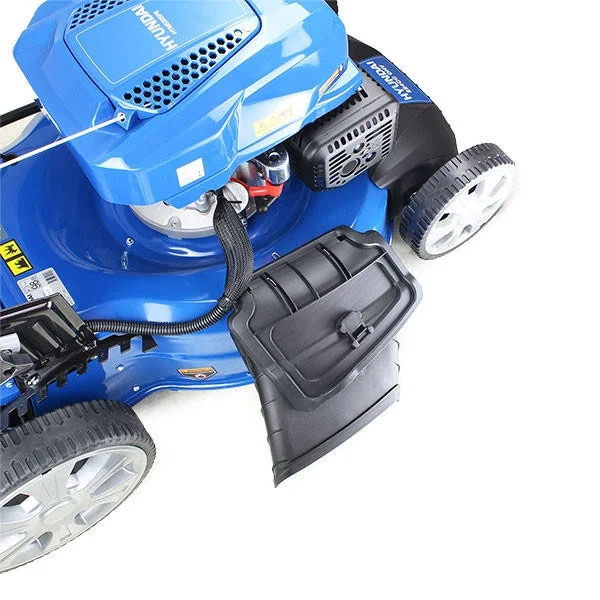
White Smoke From Lawn Mower: Causes and Fixes
Introduction to Lawn Mower Smoke Issues
Encountering smoke while mowing your lawn can be alarming. White smoke from lawn mower when starting? Understanding why your lawn mower is emitting smoke is crucial to troubleshooting the problem effectively. Whether it’s black or white smoke from lawn mower when starting, various factors can be the cause, and they typically indicate something is amiss with your mower’s internal functions.
White or blue smoke often emerges due to oil-related issues. For instance, oil might have spilled onto the engine or the oil reservoir may be filled too much. Conversely, black smoke usually points to an over-consumption of gasoline, often due to carburetor problems or a dirty air filter.
Most of these issues are manageable with some basic mechanical knowledge and a thorough read through your mower’s manual. However, if the problem seems complicated or persists after you’ve attempted a fix, seeking professional lawn mower repair might be the best course of action. Let’s delve deeper into the types of smoke you might see and what they generally signify about the state of your lawn mower.
Types of Smoke Emitted by Lawn Mowers
White or Blue Smoke
White or blue smoke from a lawn mower generally signifies oil-related issues. This type of smoke typically arises when oil has spilled onto the engine or if the oil reservoir is overly full. Tipping the mower or mowing on excessive slopes can cause oil spills. If oil spills on the engine, the lawn mower may emit white or blue smoke until the excess oil burns off. Should you notice this type of smoke, check and adjust the oil levels and ensure that you’re using the proper oil type meant for your mower.
Black Smoke
Black smoke often indicates that the lawn mower is using too much gasoline. This usually results from a problem with the carburetor not mixing the right amount of air and gasoline or a clogged air filter that restricts airflow. If your lawn mower is emitting black smoke, consider checking the air filter first and replace it if necessary. Adjusting or cleaning the carburetor can also solve the issue. If black smoke continues even after these troubleshooting steps, it may indicate a deeper mechanical problem.
Common Causes of White Smoke
White smoke from lawn mowers is usually not a sign of a major problem. It often points to oil-related issues within the lawn mower’s engine. Let’s look at some common causes.
Oil Spill on the Engine
An oil spill on the engine is the most frequent cause of white smoke. This can happen when you change the oil or if the mower tips over. If you mow on steep slopes, oil can also spill onto the engine. The white smoke is simply the oil burning off. To fix it, clean any spilled oil and run the mower until the smoke clears.
Overfull Oil Reservoir
Putting too much oil in the mower can lead to white smoke. Check the oil level with the mower’s dipstick. If it’s above the ‘full’ line, drain some oil until it’s at the correct level. Then start the mower and let it run for a short while. Watching the smoke disappear should assure you that the problem is resolved.
Incorrect Oil Type or Grade
Using the wrong type or grade of oil can cause white smoke. Each lawn mower needs a specific oil type as recommended in the owner’s manual. If you’ve used the wrong oil, drain it and replace with the appropriate type. Work carefully to avoid spills and excess oil, and monitor for any further smoke emissions.
How to Diagnose and Fix White Smoke
When dealing with white smoke from a lawn mower when starting, a few steps can help you diagnose and resolve the issue efficiently. Here are some actions you can take to identify and fix the sources of white smoke.
Checking and Adjusting Oil Levels
Checking the oil level is imperative. Use the mower’s dipstick, found at the oil reservoir. First, remove the dipstick and clean it with a rag. Then, reinsert it completely and pull it out again to check the oil mark. If it’s above the ‘full’ line, you need to drain some oil. Carefully pour out a small amount and check again until the level is correct. Start the mower and observe; if white smoke continues, but lessens, it’s likely resolving.
Understanding the Role of the Carburetor
The carburetor plays a crucial role in regulating the air and fuel mixture. If this mixture is too rich with fuel, your mower might emit white smoke. Check for any blockages or dirt in the carburetor that might be affecting its function. Cleaning the carburetor with appropriate tools and solutions may solve the issue. If unsure, consult your mower’s manual for specific instructions or consider professional help.
Replacing the Air Filter
A dirty or clogged air filter might cause improper air intake, leading to an unbalanced mix and resultant smoke. Locate your mower’s air filter — usually situated in a metal or plastic box near the carburetor. Remove the filter and assess its condition. If it shows signs of significant dirt accumulation, replace it with a new one, following the specifications in the owner’s manual. Afterwards, run the mower to see if the smoke decreases, suggesting a resolved issue.
When to Seek Professional Lawn Mower Repair
Sometimes, DIY fixes for a smoking lawn mower don’t cut it. If you’ve tried troubleshooting with no luck, it’s time to call in the experts. Let’s discuss when professional help is needed.
Persistent Blue or White Smoke
If white or blue smoke from the lawn mower when starting persists even after correcting oil levels and ensuring the use of proper oil, there might be a deeper issue. Continuous smoke could mean oil leaks in parts you can’t see or reach, or it might signal wear in engine seals or gaskets. When smoke lingers after all your efforts, it’s wise to seek a repair service.
Ongoing Black Smoke Emission
Black smoke usually points to fuel issues. If changing the air filter and cleaning or adjusting the carburetor haven’t stopped the smoke, the problem may be more complex. Potential issues could be with the fuel pump, injector, or other engine components. Continuous black smoke, despite your repair attempts, suggests it’s time to get a professional’s opinion.
Dealing with lawn mower smoke can be tricky. If fixes are out of your range, or if you’re unsure about the cause, professional help can save you time and prevent further damage. Repair experts can offer the right diagnosis and treatment for your mower’s smoking issue.
Preventative Measures and Maintenance Tips
To keep your lawn mower running smoothly and smoke-free, routine maintenance is essential. Here are some preventative tips to help you maintain your lawn mower’s performance.
Regularly Checking Oil Levels
Make it a habit to check oil levels before each use. Doing so can prevent overfilling and oil spills. Use the dipstick to measure, and fill only to the recommended mark.
Proper Mowing Techniques to Avoid Oil Spills
When mowing, use flat surfaces to prevent oil from spilling over the engine. If you have to mow on slopes, keep them gentle – under 15 degrees when possible.
Keeping Air Filters Clean
Inspect the air filter frequently, especially in dusty conditions. Clean or replace the filter as needed to ensure optimal airflow and prevent that troublesome black smoke.
FAQs on Lawn Mower Smoke Problems
White smoke from a lawn mower when starting might cause concern. Here are answers to some frequently asked questions that can help you understand the issue better.
Can low oil cause white smoke?
Yes, low oil can lead to white smoke. Check your mower’s oil level if you see this smoke.
Can dirty air filters cause white smoke?
No, dirty filters often cause black smoke, not white. Black smoke means too much gas is burning.
Does white smoke always mean a blown head gasket?
White smoke does not always signal a blown gasket. It often suggests spilled oil or low oil.
How much white smoke is normal from exhaust?
Any white smoke from a lawn mower is not normal. Smoke indicates a potential issue to fix.
